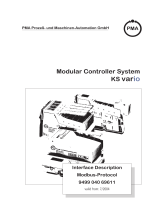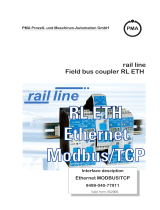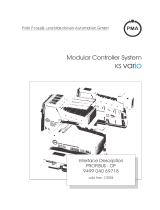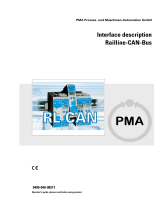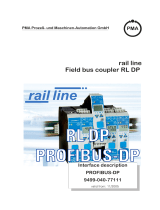
Modular Controller System
KS vario
Interface Description
ETHERNET
9499 040 69811
valid from: 7/2004
PMA Prozeß- und Maschinen-Automation GmbH

BlueControl ®is a registered trademark of PMA Prozeß- und Maschinen-Automation GmbH
© PMA Prozeß- und Maschinen-Automation GmbH
Printed in Germany
All rights reserved. No part of this document may be reproduced or published in any form or by any
means without prior written permission from the copyright owner.
A publication of PMA Prozeß- und Maschinen Automation GmbH
Postfach 310229
D-34058 Kassel
Germany

9499-040-69811 3 preliminary
Content
1. General ...........................................5
2. Hints for operation .......................................5
2.1. Connecting the interface ................................5
2.2. Signification of indicator LEDs on the bus coupler...................6
2.3. Forcing .........................................6
2.4. Fail-safe ........................................6
3. Communication via Ethernet .................................7
3.1. Physical Layer......................................7
3.2. Data link layer Ethernet / MAC-ID ...........................7
3.3. Network layer IP ....................................7
3.4. Transport layer .....................................7
3.5. Application layer Modbus/TCP .............................7
3.6. IP address of the KS vario system via BootP protocol .................8
3.7. IP address of the KS vario system via “BlueControl”engineering tool.........8
3.8. Modbus TCP message format (Application Data Unit).................8
3.9. Function codes .....................................9
4. Addressing in the Ethernet bus coupler ..........................10
4.1. Access to data of the cache memory in the bus coupler ...............10
4.1.1 Definition of transmitted values in the “BlueControl” engineering tool . . 11
4.1.2 Structure of and access to the data cache in the Ethernet bus coupler. . . 12
4.2. Free access to any KS vario data ...........................13
5. General information on the RTU Modbus protocol ....................17
5.1. General ........................................17
5.1.1 General message structure .........................17
5.1.2 Parity (PrtY)..................................17
5.1.3 CRC ......................................18
5.1.4 End identier..................................18
5.1.5 Modbus function format ...........................18
5.1.6 Modbus Functioncodes............................19
5.2. Examples .......................................20
5.2.1 Read process data data, parameter or configuration data .........20
5.2.2 Write a single data (process data, parameter or configuration).......21
5.2.3 Writing several process data, parameter and configuration data .....22
5.2.4 Read-out and specification of data in float format .............23
5.3. Error report ......................................24

preliminary 4 9499-040-69811

.1. General
Modular controller system KS vario permits connection of various fieldbus interfaces. For this purpose, the relevant bus
coupler is used as a head station for a controller system.
Via one of these bus couplers, the ETHERNET (Modbus/TCP protocol) is supported by means of a front-panel interface
(PJ45 connector). Hereby, transmission of all process, parameter and configuration data is possible.
This communication interface permits communication with supervisory systems, visualization tools, etc.
Another standard interface is provided on the KS vario controller modules. This full RS232 interface is used for
connection of the ‘BlueControl’ tool, which runs on a PC.
Transfer rate The Ethernet coupler works as a ModbusTCP server with a maximum transfer rate of 100Mbit.
Clients The Ethernet bus coupler permits communication with up to 4 clients via the TCP/IP protocol.
.2. Hints for operation
2.1. Connecting the interface
Connect the Ethernet to the front-panel RJ45 interface of the bus coupler.
10BaseT or 100BaseT are used as physical layer.
Physical connection is via Ethernet using twisted two-wire cable (CAT5 cable, 8-pole in RJ-45 connection technology).
Pin allocation
RJ-45
Connection is via an RJ-45 socket, with 2 integrated LEDs.
Green LED on: connected to Ethernet
Yellow LED on:traffic on Ethernet
Contact Signal Description
1 TD + Transmit +
2 TD - Transmit -
3 RD + Receive +
4 - unused
5 - unused
6 RD - Receive -
7 - unused
8 - unused
9499-040-69811 5 preliminary

2.2. Signification of indicator LEDs on the bus coupler
LEDs
LED no. LED colour Function
US green 24 V segment voltage provided
UM green 24V main supply provided
(presently not used)
UB green 24V coupler voltage provided
D1 red ON: no connection to client
D2 red BLINKING: faulty communication
OFF: correct communication
2.3. Forcing
Inputs All physical inputs can be overwritten (configurable) via ETHERNET. Thus e.g. process value measurement via remote
I/O (e.g. VARIO I/O system ) and entry via the bus are possible.
Outputs With output forcing, the fail-safe function setting must be taken into account. If "zero" fail-safe behaviour was
adjusted, all outputs are set to zero in case of bus error or master stop, otherwise, their old value remains unchanged. .
2.4. Fail-safe
User parameter setting ‘fail-safe’ determines the instrument behaviour in case of master bus failure or 'bus stop' .
Bus failure
In case of bus failure, the instrument operates according to the following rules.
Fail-safe Reaction in case of bus failure or master stop
Last value Continue operation with the values sent last
Forced analog inputs are set to FAIL
zero Forced analog inputs are set to FAIL 1) .
Forced digital inputs are set to zero
Forced outputs are set to zero
preliminary 6 9499-040-69811
US
UM
UB
D1
D2
PMA

.3. Communication via Ethernet
3.1. Physical Layer
10BaseT or 100BaseT is used as physical layer.
3.2. Data link layer Ethernet / MAC-ID
Ethernet transports Ethernet packets from a sender to one or several receivers without acknowledgement and without
repetition of lost packets.
Senders and receivers of Ethernet packets are addressed via the MAC-ID. The MAC-ID is a 6-byte ident code, which is
unambiguous, i.e. worldwide different for each unit connected to Ethernet. The MAC-ID consists of two parts. The first
part, i.e. the first 3 bytes, are a manufacturer identification.
The identification of PMA GmbH is 00 0E 0D. The next 3 bytes are determined by the manufacturer and correspond to a
series number. They are unique. The MAC-ID can be used, for instance, for the BOOTP protocol for adjustment of the
TCP/IP number.
For this purpose, a telegram including the information such as name or TCP/IP number is sent to the relevant node.
3.3. Network layer IP
Basis of data communication is the Internet protocol (IP). IP transports data telegrams between communicating units
connected in the same or a different network and provides address management (finding and assignment of MAC-Ids),
segmenting and routing.
3.4. Transport layer
The IP-based transmission control protocol (TCP) enables two hosts to establish a connection and exchange streams of
data. It includes treatment mechanisms. Lost telegrams are repeated.
UDP is a connection-less transport protocol. It does not include control mechanisms during data exchange between
sender and receiver.
This results in a higher processing speed than e.g. with TCP. Checking, whether the telegram has arrived must be done
by the superordinate protocol.
3.5. Application layer Modbus/TCP
Modbus/TCP is a Modbus communication based on the TCP/IP transmission protocols. Ethernet is used as transmission
standard. ModbusTCP follows the client-server model, whereby the ModbusTCP server provides services for clients.
Communication is started by a ‘request’ made by a Modbus TCP client. The server replies this ‘request‘ with an
‘indication‘. When processing in the client is finished, the server sends a ‘response‘ to the client, which is replied with
a ‘confirmation’.
Communication via bridges, routers or gateways is possible.
In the Ethernet bus coupler, the Modbus protocol in RTU (Remote Terminal Unit) mode is used, i.e. each transmitted
message byte contains two hexadecimal characters (0..9, A..F).
Further information is given in the “Modicon Modbus Protocol Reference Guide” of Modicon, Inc., Industrial
Automation Systems. See also chapter 5: “Information on the Modbus protocol”.
9499-040-69811 7 preliminary

3.6. IP address of the KS vario system via BootP protocol
IP-address and sub-net mask can be requested with the BootP protocol. After power-on, the BootP protocol is always
sent, unless an own IP addr. is known. Known means that it was determined using the “BlueControl” engineering tool .
3.7. IP address of the KS vario system via “BlueControl”engineering tool
IP address (4 bytes) and sub-net mask (4 bytes) can be entered into KS vario by the BlueControl tool. KS vario transmits
this information to the bus coupler during transmission. If the IP address is determined as “0” via the tool, the bus
coupler detects this address as invalid and address determination via Boot P becomes relevant.
3.8. Modbus TCP message format (Application Data Unit)
The ADU (Application Data Unit) structure is shown below:
ADU structure
Fields Length Description - Client Server
Transaction
Identifier
2 Bytes Identification of a MODBUS
Request / Response
transaction.
Initialized by the
Client
Recopied by the server from
the received request
Protocol
Identifier
2 Bytes 0 = MODBUS protocol Initialized by the
Client
Recopied by the server from
the received request
Length 2 Bytes Number of following Bytes Initialized by the
Client (request)
Initialized by the
Server(response)
Unit
Identifier
1 Byte Identification of a remote
slave connected on a serial
line or on other buses.
Initialized by the
Client
Recopied by the server from
the received request
Function-
Code
1 Byte Modbus RTU Function-Code
Data x Bytes Data
preliminary 8 9499-040-69811

3.9. Function codes
The following function codes are realized in KS vario:
Function code Signification
0x03 Read process data, parameters or configuration data
0x04 Read process data, parameters or configuration data
0x06 Write a single datum (process data, parameters or configuration)
0x10 Write several data (process data, parameters or configuration)
0x17 Read/write register
Write outputs wordwisely with start address and number of outputs
Read inputs wordwisely with start address and number of inputs
0x2B Read Device Identification
Read manufacturer name, product code and software version. For details, see
chapter 5 “Information on the Modbus protocol”.
Note: No difference between function codes 03 and 04 is made, because it is not possible to make sure that all
masters support both function codes. Function codes 0x17 and 0x2B are supported only by the bus coupler. Thus
access to the process data caches is possible. Free access to any other KS vario data is not possible with this function
code.
9499-040-69811 9 preliminary

.4. Addressing in the Ethernet bus coupler
In addition to the access to all parameters and data via Modbus addresses, access to selected data (max. 1080 per
direction) of a cache via the BlueControl tool is possible.
Addressing is done via the unit identifier data field of the MBAP header.
Unit Identifier=0or1 --> access to data of the cache memory in the bus coupler
Unit Identifier = 2..255 --> access to KS vario data
4.1. Access to data of the cache memory in the bus coupler
Access using
Unit Identifier
=0 or 1.
Any process data and parameters can be selected in KS vario using the BlueControl tool. This data is updated
continuously in the bus coupler cache memory.
The process data cover a data range of 1080 word data in the write cache and read cache.
preliminary 10 9499-040-69811

4.1.1 Definition of transmitted values in the “BlueControl” engineering tool
BlueControl provides two methods for selecting the data to be read (analogous for write direction):
qAny max. 120 parameters and process data from different channels for writing and max. 120 for
reading. The position determines the order of transmission.
qAdditionally or as an alternative, any max. 32 parameters and process data can be selected in common
for all channels. Thus e.g. the process values from all channels (max. 30) can be transmitted by
selecting a datum. In total,. max. 960 write and read data can be defined (32 data x 30 channels).
These selected data (max. 1080 write and 1080 read data) are available in the bus coupler asa cache memory in the
order defined in BlueControl. The indexes or offsets of the individual data are displayed via the BlueControl tool or can
be printed out.
9499-040-69811 11 preliminary

4.1.2 Structure of and access to the data cache in the Ethernet bus coupler
The process data cover a data area of 1080 word data in the write cache and in the read cache. Access is using the
following addresses:
Modbus address Data area Access mode
1...1080 Read cache Read
2001...3080 Write cache Write
Index read cache Content
1
max.120
Any data from any channels
max. 121
max. 1080
Selected data (identical for all channels):
All channel 1 data
All channel 2 data
...
All channel 30 data
Index write cache Content
1
max.120
Any data from any channels
max. 121
max. 1080
Selected data (identical for all channels):
All channel 1 data
All channel 2 data
...
All channel 30 data
preliminary 12 9499-040-69811

4.2. Free access to any KS vario data
Access using
Unit Identifier
= 2..255
The address is coded in 2 bytes. The 2 most significant bits (D15, D14) are used to define the format in which the data
are written or read.
The Modbus directory is divided into segments of equal size of 512 words each (bit D13...D09). Each of these segments
can be used for access to all data for one control channel at a time (1...30 channels).
2 segments have a special status. In the lowest addresssegment (Modbus addr. 0..512), all device data are stored. The
following segment (addr. 512...1023) contains the most important process data from all 30 channels additionally. This
segment is intended for access by visualization facilities.
+For a detailed address survey of all data, see document:
Parameter table for KS vario (9499-040-72918)
The signification of address bits is as given on the following page.
9499-040-69811 13 preliminary

INTEGER/ FIX-Point Modbus addresses:
MSB LSB
D15 - D14 D13 - D09 D08 - D00
Data format Device, visualization, channel X
Relevant datum
00: Integer
01: Fix Point 1
1X: reserved for float
00000: device data
00001: visualization data
00010: channel 1 data
00011: channel 2 data
....
11111: channel 30 data
Modbus directory (data format: integer):
For the Fix Point 1 area, 4000 hex must be added for the addresses.
Addresses Data
0
511 (1FF hex)
Device data
512 (200 hex)
1023 (3FF hex)
Visualization area
Channel 1..30
1024 (400 hex)
1535 (5FF hex)
Channel 1 data
1536 (600 hex)
2047 (7FF hex)
Channel 2 data
.... ....
15872 (3E00 hex)
16383 (3FFF hex)
Channel 30 data
preliminary 14 9499-040-69811

FLOAT Modbus addresses:
MSB LSB
D15 D14 - D10 D09 - D00
Data format Device, visualization, channel X
relevant datum (offset 2)
0: reserved for integer
and Fix Point 1
1: Float
00000: device data
00001: visualization data
00010: channel 1 data
00011: channel 2 data
....
11111: channel 30 data
Modbus directory (data format: FLOAT):
Addresses Data
32768 (8000 hex)
33791 (83FF hex)
Device data
33792 (8400 hex)
34815 (87FF hex)
Visualization area
Channel 1..30
34816 (8800 hex)
35839 (8BFF hex)
Channel 1 data
35840 (8C00 hex)
36863 (8FFF hex)
Channel 2 data
.... ....
64512 (FC00 hex)
65535 (FFFF hex)
Channel 30 data
These data are 4 bytes long each.
9499-040-69811 15 preliminary

Values which can be transmitted:
Integer: -30000 ... +32000 (resolution: +/-1)
Fix Point 1: -3000.0 ...+3200.0 (resolution: +/- 0,1)
Float: -1.0 E+037...+1.0 E+037 (resolution: +/- 1.4E-045)
The following special values are defined during transmission in integer format:
-31000 This datum is not defined. This value is returned by the controller, unless
a datum within a block is defined with block reading.
-32000 The function is switched off.
-32768 Corresponds to 0x8000 hex. The value to be transmitted is out of the integer range which can be
transmitted.
The following special values are defined for transmission in float format:
-1.5E37 This datum is not defined. This value is returned by the controller,
if a datum within the block is not defined with block reading.
In the code tables (parameter tables for KS vario (9499-040-72918)), the addresses of each parameter for the relevant
data format in decimal values are specified (addr. = integer without digits behind the decimal point; 1 dP = integer with
1 digit behind the decimal point; real = float (IEEE format)).
preliminary 16 9499-040-69811

.5. General information on the RTU Modbus protocol
5.1. General
The MODBUS protocol was defined for communication between a supervisory system and the Modicon control system.
ASCII and RTU protocols were defined. Instrument KS VARIO supports the RTU protocol.
The structure for transfer of a byte in the RTU protocol is:
Start bit 8 data bits Parity/stop bit Stop bit
Even or odd parity bit can be selected. Unless a parity bit is selected, an additional stop bit is transferred.
5.1.1 General message structure
The message is read in into a data buffer with a max. length of 250 bytes. Longer messages are not accepted. The
instrument does not reply.
The message is composed of the following elements:
Instrument address Function code Data CRC End identifier
•Instrument address (Addr)
The instrument address specifies the instrument. Instrument addresses within 1 - 247 can be defined.
Instrument address 0 is used as a broadcast message. A broadcast message can be defined for write orders,
which are handled by all instruments on the bus. As all instruments handle the order, no reply by the instruments
is given.
•Function code
The function code defines the type of a message. There are 17 defined messages. Which messages are
supported is described in chapter ”Data and function control”.
•Data
The data block comprises the further specification of the action defined with the function code. The data block
length is dependent of function code. For further information, see chapter ”MODBUS function format” (chapter 4
). The internal data buffer includes 256 bytes. I.e., max. 120 integer or 60 real data of a message can be written
or read out.
•CRC
The CRC code ensures that transmission errors can be detected. For further information, see chapter ”CRC”.
•End identifier
The end of a message is defined by a time of 3,5 characters without data transfer. For further information, see
chapter ”End identifier”.
5.1.2 Parity (PrtY)
Even, odd or no parity can be selected.
The parity bit can be used for checking, if there was a single error within a byte during transmission.
With even parity, the parity bit is set so that the sum of set bits in the 8-data bits and the parity bit is an even number.
This is applicable analogously to odd parity.
When detecting a parity error during reception, no reply message is generated.
Unless a parity is selected, 1 or 2 stop bits can be output (determination via configuration).
9499-040-69811 17 preliminary

5.1.3 CRC
The CRC is a 16-bit value which is appended to the message. This value is used to determine, if the transmission of a
message was detected correctly. In conjunction with parity checking, all possible transmission errors should be
detected.
When detecting a parity error during transmission, no reply message is generated.
The algorithm for generating the CRC is:
•Load the CRC register with FFFF
•Exclusive OR function of the send/receive bytes with the high portion of the CRC register
•Shift the CRC register right by 1 bit
•If the shifted bit was 1, connect the CRC register with value A001 by an exclusive OR function.
•Repeat steps 3 and 4 for the other 7 data bits.
•Repeat steps 2 to 5 for all other send/receive bytes.
•Append the result of the CRC register to the message, starting with the high portion. When checking a receive
message, the result in the CRC register is 0, if the message is handled inclusive of the CRC.
5.1.4 End identier
The end identifier of a message is specified as rest situation on the Modbus with a length of 3,5 characters. This time
must elapse, before a slave may start its reply, or before a master can send another message.
The evaluation of a message may start, when the rest condition on the Modbus was met during more than 1,5
characters. However, a reply is started only after 3,5 characters.
5.1.5 Modbus function format
The signification of the data range is different dependent of function code. The Modbus protocol defines 17 different
functions.
To permit reading and writing of process data, parameters and configuration data with a minimum number of accesses,
the relevant ranges are grouped together, whereby process data can be defined several times in different groups.
Example for a transmission
Inquiry: Reply:
Field name Value (hex) Signification Field name Value Signification
Address 11 Address 17 Address 11 Address 17
Function 04 Read
parameter/configuration
Function 04 Read
parameter/configuration
Start address high
Start address low
03
EC
Start address 1004 Number of
bytes
06 6 data bytes are sent
Number of values 00
03
Number of values 03 Value1 04
2A
Value1 = 1066
CRC CRC byte1
CRC byte2
Value2 00
8C
Value2 = 140
Value3 10
3E
Value3 = 4158
CRC CRC byte1
CRC byte2
preliminary 18 9499-040-69811

5.1.6 Modbus Functioncodes
Codetable see chapter 3.9
Details for functionscode 43 (0x2B), Read Device Identification:
Object ID Object Name / Description Type M/O category
0x00 VendorName ASCII String Mandatory Basic
0x01 ProductCode ASCII String Mandatory
0x02 MajorMinorRevision ASCII String Mandatory
0x03 VendorUrl ASCII String Optional Regular
0x04 ProductName ASCII String Optional
0x05 ModelName ASCII String Optional
0x06 UserApplicationName ASCII String Optional
0x07
…
0x7F
Reserved Optional
0x80
…
0xFF
Private objects may be optionally defined. The
range (0x080 - 0xFF) is product depandant
Device
dependant
Optional Extended
Accessses at the basic- and regular-objects are supported. Level 2 is supported as conformity level [regular
identification (stream access only)].
REQUEST
Function Code 1 Byte 0x2B
MEI Type * 1 Byte 0x0E
Read Device ID code 1 Byte 01 / 02 / 03 / 04
Object ID 1 Byte 0x00 to 0xFF
MEI= Modbus Encapsulated Interface
RESPONSE
Function Code 1 Byte 0x2B
MEI Type 1 Byte 0x0E
Read Device ID code 1 Byte 01 / 02 / 03 / 04
Conformity level 1 Byte
More Folows 1 Byte 00 / FF
Next Object Id 1 Byte Object ID number
Number of objects 1 Byte
List of
Object ID 1 Byte
Object length 1 Byte
Object Value Object length Depending on the object ID
ERROR
Function Code 1 Byte 0xAB:
Fc 0x2B + 0x80
MEI Type 1 Byte 14
Exception Code 1 Byte 01, 02, 03, 04
Object Contens:
Object: 0 = PMA Prozeß- und Maschinen-Automation GmbH
Object:1=KSVARIO BK ETH
Object: 2 = V1.00 (aktuelle Softwareversion)
Object: 3 = pma-online.de
Object: 4 = KSvario
Object: 5 = Ethernet
Object: 6 = KSVC-101-00131
9499-040-69811 19 preliminary

5.2. Examples
5.2.1 Read process data data, parameter or configuration data
The structure of a message is:
Inquiry:
Field name Value Signification
Address 11 Address 17
Function 03 or 04 Read process data data, parameter or configuration data
Start address high
Start address low
04
98
Start address 0498 ( ti1 / channel 1)
Number of values 00
02
2 data
CRC CRC byte1
CRC byte2
Reply:
Field name Value Signification
Address 11 Address 17
Function 03 or 04 Read process data data, parameter or configuration data
Number of bytes 04 4 data bytes are sent
Parameter1 00
B4
Process data data, parameter/configuration datum
0498= 180
Parameter ti2 01
4D
Process data data, parameter/configuration datum
0499= 333
CRC CRC byte1
CRC byte2
Broadcast is not possible.
Unless the 1st parameter / configuration datum was defined, error message ”ILLEGAL DATA ADDRESS” is generated.
Unless other values after the 1st value in the area to be read out are defined, these are entered with value ”NOT
DEFINED VALUE”. This can be used for reading out areas with gaps using a message
5.2.2 Write a single data (process data, parameter or configuration)
The structure of a message is:
Inquiry:
Field name Value Signification
Address 11 Address 17
Function 06 Write a single datum (process data, parameter or configuration)
Write address high
Write address low
0D
57
Write address 15990 (SetpInterface of channel 30)
Value = 123 00
7B
CRC CRC byte1
CRC byte2
Reply:
Field name Value Signification
Address 11 Address 17
Function 06 Write a single datum (process data, parameter or configuration)
Write addr. high
Write addr. low
3E
76
Write address 15990 (SetpInterface of channel 30)
Value = 123 00
7B
CRC CRC byte1
CRC byte2
preliminary 20 9499-040-69811
Page is loading ...
Page is loading ...
Page is loading ...
Page is loading ...
/
